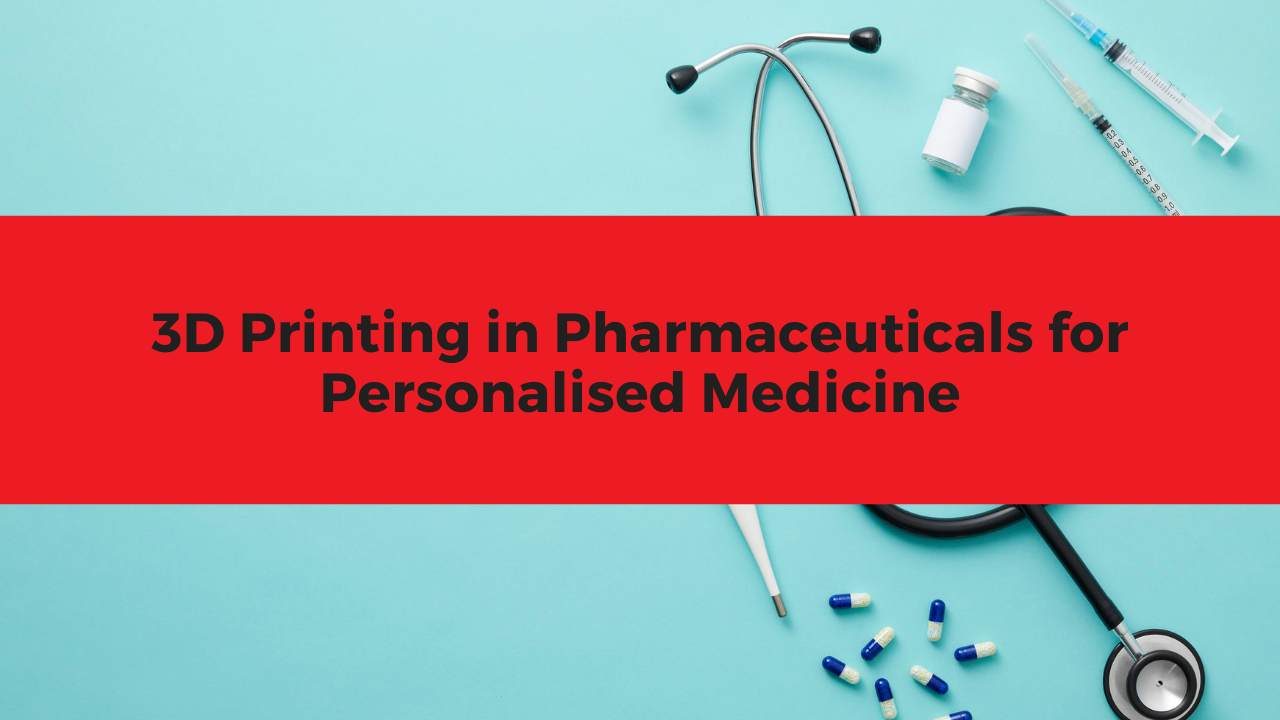3D Printing in Pharmaceuticals for Personalised Medicine
3D printing, once associated mainly with engineering and design, is now transforming the pharmaceutical industry. Researchers and pharmaceutical companies are exploring how this innovative technology can be used to create oral solid dose medicines that are personalized for each patient. Instead of relying on mass-produced tablets with standard strengths, 3D printing offers the ability to make medicines tailored to an individual’s needs, marking a significant step toward truly personalised healthcare. Let’s take a deeper dive into 3D printing of medicines.
What is 3D Printing in Pharmaceuticals?
3D printing, or additive manufacturing, is the process of building a three-dimensional object layer by layer using digital design software. In the pharmaceutical world, it allows scientists to precisely control the amount of drug in each tablet and how it is released in the body customised for the patient. Unlike traditional tablet pressing, which produces identical doses, 3D printing allows the production of patient-specific medicines. This flexibility means that doses can be fine-tuned to an individual’s needs, improving safety and therapeutic outcomes.
How 3D Printing is Revolutionising Oral Solid Dose Medicines
3D printing is revolutionizing oral solid dose medicines by enabling completely customized doses, tablet designs, and drug release patterns. Using this technology, scientists can produce a tablet that fits an individual patient’s prescription, medical condition, and even swallowing preferences.
At UCL School of Pharmacy, scientists have designed pills with varying release profiles some dissolve instantly, while others release medicine slowly over several hours. Researchers at the University of Nottingham are also experimenting with combining several medications into a single printed pill, reducing the number of tablets patients must take each day. These advancements show how 3D printing is paving the way for truly personalized therapy.
First 3D Pill in Production
The first real-world success came from the United States, where Aprecia Pharmaceuticals, in collaboration with the Massachusetts Institute of Technology (MIT), developed Spritam (levetiracetam). Approved by the U.S. Food and Drug Administration (FDA) in 2015, it became the world’s first 3D-printed drug. Spritam uses ZipDose technology, which builds a highly porous tablet that dissolves in seconds with a small amount of water, making it ideal for patients with epilepsy who struggle to swallow large tablets.
Following this breakthrough, researchers at FabRx began developing their own line of personalized medicines known as Printlets. Their studies, conducted at UCL, have shown how these printed tablets can be customised in dosage, colour, and flavour, making them suitable for use in hospitals and pharmacies to serve individual patient needs.
Techniques in 3D Printing
Different teams of scientists and researchers have established differing 3D printing techniques for pharmaceuticals as follows:
Fused Deposition Modeling (FDM)
Researchers at the University of Copenhagen have demonstrated that FDM can produce sustained-release tablets. This method works by pushing a heated drug-polymer mixture through a nozzle to form thin layers that gradually build a complete tablet.
Inkjet Printing
At the University of Central Lancashire and AstraZeneca, scientists have developed inkjet-based drug printing, which sprays droplets of a liquid formulation in precise patterns. This technique is particularly useful for low-dose or pediatric medicines.
Stereolithography (SLA)
Teams from the University of Santiago de Compostela in Spain have experimented with SLA printing, using light to harden liquid resins that contain the active drug. This technique produces extremely precise tablets with controlled drug-release properties.
Selective Laser Sintering (SLS) Researchers in Germany and Singapore have tested SLS, where lasers fuse powder particles into solid tablets. Their studies show that adjusting the laser intensity can influence how quickly the drug dissolves, creating tablets tailored for different therapeutic needs.
Pros and Cons of 3D Printing in Pharmaceuticals
The following are advantages and disadvantages outlined by scientists and researchers from UCL, the University of Nottingham, the University of East Anglia, and international pharmaceutical research institutions:
Pros
- Enables precise, patient-specific doses for individualized therapy.
- Allows creative tablet designs and customizable release rates.
- Minimizes material waste and supports sustainable production.
- Improves patient adherence through custom tablet sizes and flavors.
- Encourages innovation through flexible, small-scale manufacturing.
Cons
- Equipment and pharmaceutical-grade material costs remain high.
- Limited range of printable excipients and polymers.
- Regulatory pathways are still evolving globally.
- Maintaining product stability and uniformity requires further research.
- Requires specialised training and cross-disciplinary expertise.
Development of “Polypills”
Research from the University of East Anglia and FabRx demonstrates that 3D printing makes personalized treatment more practical and accessible. Scientists have designed “polypills” that combine multiple drugs for chronic conditions such as hypertension and diabetes for individual patients in customised doses, simplifying complex medication routines.
Limitations of 3D Printing in Pharmaceuticals
Researchers from the University of Lisbon and the University of Helsinki report that one of the main limitations of 3D printing in pharmaceuticals is the small number of approved, safe materials that can be used for printing medicines. Certain printing methods also expose drugs to heat or ultraviolet light, which can damage sensitive compounds.
Regulatory agencies such as the FDA and EMA are still developing clear quality standards and approval pathways, which slows down clinical adoption. Additionally, scientists at the University of Nottingham note that implementing 3D printing in hospitals requires new infrastructure and staff training to ensure safe and consistent production.
Future outlook of 3D Printing in Pharmaceuticals
Researchers from Harvard University’s Wyss Institute predict that 3D printing will play a central role in future on-demand, decentralized drug manufacturing. Hospitals and pharmacies may one day print custom medicines immediately after a patient’s consultation.
In Europe, scientists from the University of Santiago de Compostela are integrating artificial intelligence with 3D printing to automatically adjust dosages and drug combinations based on patient data.
Meanwhile, researchers at the University of Nottingham are exploring sustainable materials to reduce waste and environmental impact. Together, these initiatives point toward a future where medicine is digitally designed, intelligently produced, and personally optimised.
Conclusion
3D printing promises to significantly improve patient outcomes and innovation in this field is ramping up. From MIT’s partnership with Aprecia Pharmaceuticals that produced the first FDA-approved 3D-printed pill, to FabRx’s work at University College London developing customisable Printlets®, innovation in this field continues to grow rapidly and represents a huge and remarkable advancement for the industry.
References
Aprecia Pharmaceuticals. (2015). Spritam® (levetiracetam) FDA approval announcement. U.S. Food and Drug Administration. https://www.aprecia.com
FabRx Ltd. (2023). 3D printing of personalized medicines using Printlets® technology. University College London Spin-Out. https://www.fabrx.co.uk
Goyanes, A., Wang, J., Buanz, A. B., Martínez-Pacheco, R., Telford, R., Gaisford, S., & Basit, A. W. (2015). 3D printing of medicines: Engineering novel oral devices with unique design and drug release characteristics. International Journal of Pharmaceutics, 494(2), 657–663.
Khaled, S. A., Burley, J. C., Alexander, M. R., Yang, J., & Roberts, C. J. (2015). 3D printing of five-in-one dose combination polypills for the treatment of cardiovascular disease. Journal of Controlled Release, 217, 308–314.
Wong, J., & Pfister, W. R. (2018). 3D printing of pharmaceuticals: From hype to reality. Drug Development and Industrial Pharmacy, 44(8), 1219–1225.Zhang, J., & Xu, X. (2022). Advances in 3D printing for personalized drug delivery.Journal of Pharmaceutical Sciences, 111(5), 1342–1355.


